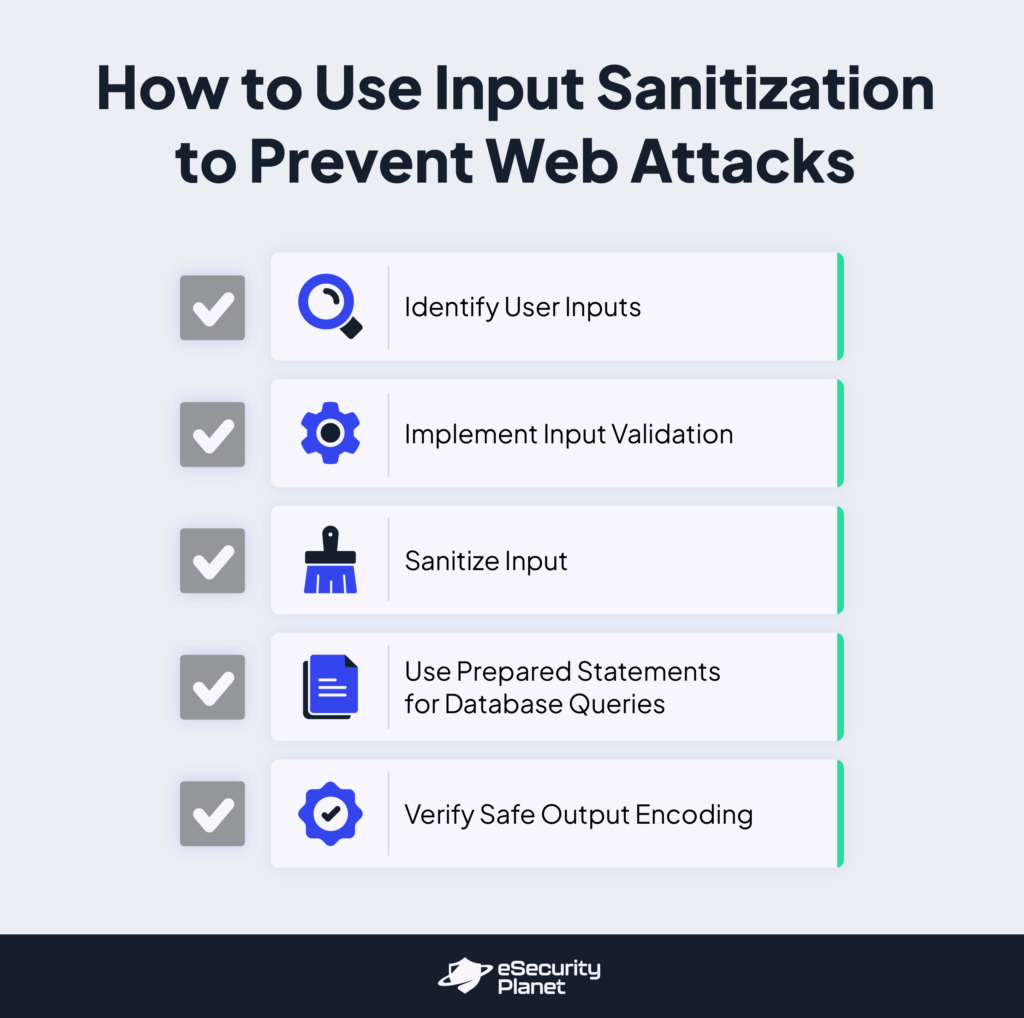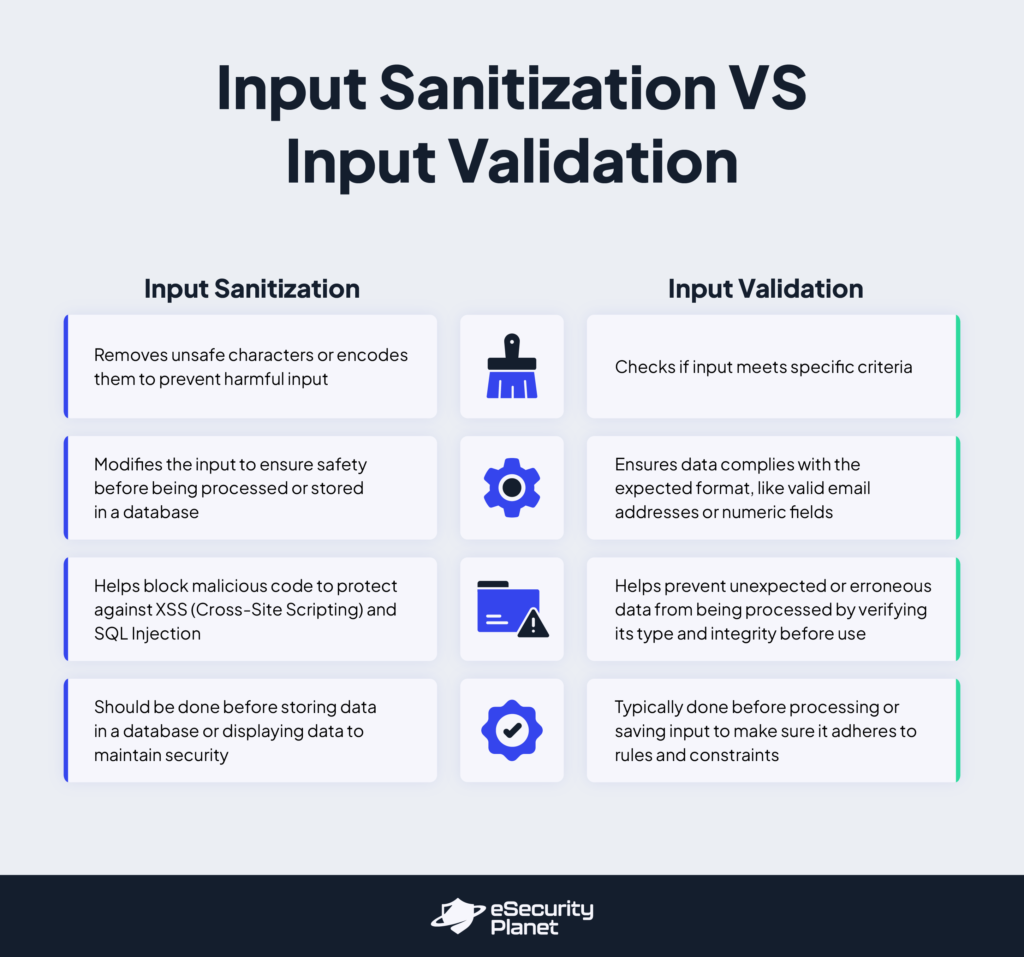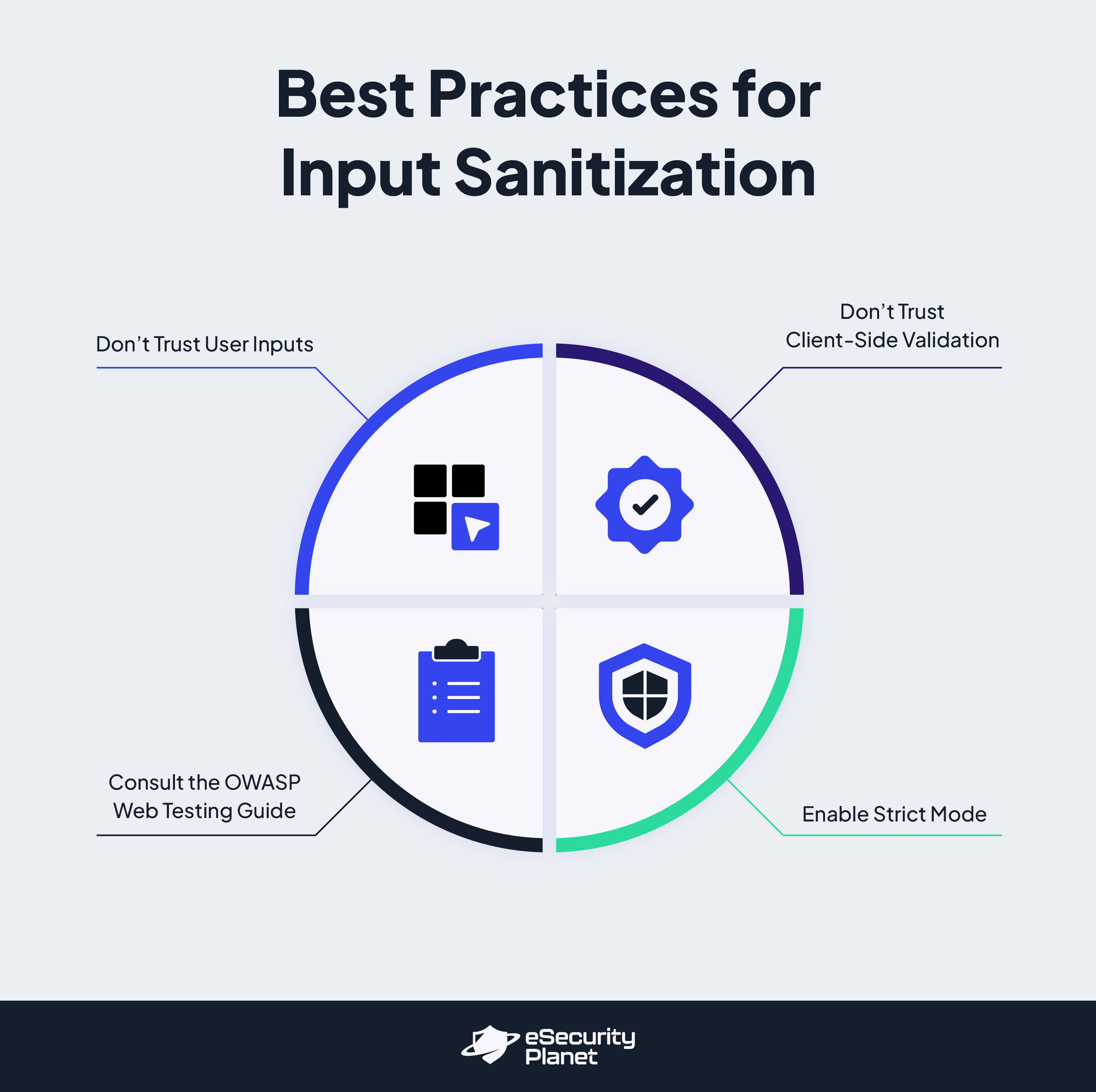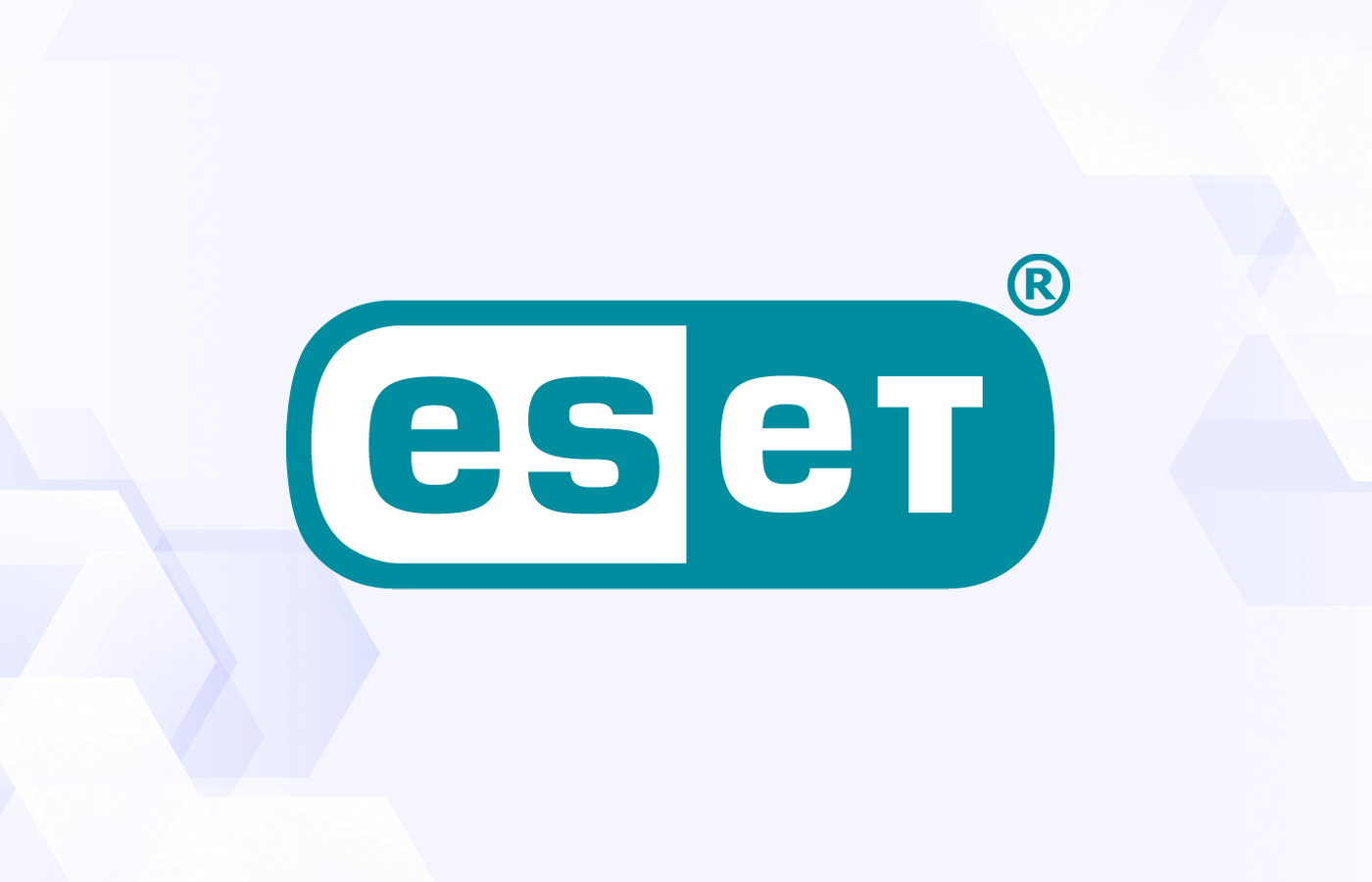Input sanitization is the process of modifying or removing potentially harmful data entered by users to prevent web-based attacks like SQL injection and cross-site scripting (XSS). Despite all of our investments in security tools, the codebase can be the weakest link for any organization’s cybersecurity.
Sanitizing and validating inputs is usually the first layer of defense. By ensuring that only properly formatted and safe input is processed, developers can reduce the risk of malicious code execution, data breaches, and application failures.
Here, we’ll cover input sanitization and validation, as well as other key factors, such as server configurations, to help secure web forms effectively.
Steps in Using Input Sanitization to Prevent Web Attacks
Cybercriminals continue to exploit common vulnerabilities to launch cyberattacks like SQL injection, cross-site scripting (XSS), remote file inclusion (RFI), and directory traversal. While more advanced threats exist — such as adversarial machine learning, advanced obfuscation, and zero-day exploits — classic attacks remain prevalent and still account for most security breaches. To prevent such risks, developers must sanitize and validate data correctly before processing or storing them.

- Identify User Inputs: Review all entry points in your applications where users can submit data, such as forms and search bars. This also includes GET and POST requests, cookies, and any other user-submitted inputs.
- Implement Input Validation: Ensure that user inputs adhere to strict, defined rules for data types, lengths, and allowed characters. For example, if expecting a number, check if the input is indeed numeric. Use validation functions like
filter_var()in PHP or regex patterns in JavaScript. - Sanitize Input: Once validated, sanitize the input by removing or encoding potentially malicious characters. For PHP, you can try functions like
htmlspecialchars()orhtmlentities(). For JavaScript, you useencodeURIComponent(). - Use Prepared Statements for Database Queries: Avoid directly inserting user inputs into SQL queries. Instead, use prepared statements with bound parameters to prevent SQL injection attacks. This way, inputs are treated as data, not executable code.
- Verify Safe Output Encoding: When displaying user input, ensure it’s properly escaped to avoid XSS. This is particularly important for data being output in HTML, JavaScript, or URL parameters.
- Test Input Validation and Sanitization: Regularly test all input fields for vulnerabilities using automated security tools and manual penetration testing. Verify that no harmful inputs can bypass your validation and sanitization procedures.
What Is the Difference Between Sanitizing and Validating Input?
Sanitizing consists of removing any unsafe characters from user inputs, while validating will check to see if the data is in the expected format and type. Sanitizing modifies the input to ensure it’s in a valid format for display, or before insertion in a database.

Conversely, validation checks whether an input — say on a web form — complies with specific policies and constraints (such as, single quotation marks). For example, consider the following input:
<input id="num" name="num" type="number" />
If there’s no validation, nothing prevents an attacker from exploiting the form by entering unexpected inputs instead of an expected number. They could also try to execute code directly if submitted forms are stored in a database, which is common.
To prevent such a bad situation, developers must add a validation step where the data is inspected before proceeding. For example, using a popular language like PHP, you can check the data type, length, and many other criteria.
Why You Should Use Input Sanitization and Validation
Input sanitization and validation are necessary to prevent attackers from exploiting weak input fields to inject malicious code, manipulate databases, or compromise user data. These security measures ensure that only safe, expected data is processed by an application, reducing security risks.
The most common techniques used against weak inputs are XSS attacks, where attackers inject malicious scripts into otherwise trustworthy websites.
Some XSS attacks are more obvious than others. If you take the time to sanitize and validate your inputs, a skilled attacker might still find a way to inject malicious code under specific conditions.
A classic attack demo consists of injecting the following script in a weak input, where the placeholder ‘XSS’ is arbitrary JavaScript:
<script>alert('XSS')</script>
If the input content is displayed on the page, the attacker can execute arbitrary JavaScript on the targeted website. The typical case is a vulnerable search input that displays the search term on the page:
https://mysite.com/?s=<script>alert('XSS')</script>
It gets worse if the malicious entry is stored in the database. The demo code might look fun to play with, but in real-world conditions, attackers can do a lot of things with JavaScript, sometimes even stealing cookies.
When Not to Use Sanitization
Sanitization should not be used as the sole security measure because it doesn’t prevent all forms of attacks and can inadvertently remove necessary data.
The biggest problem with sanitization is the false impression of network security it might give. Stripping unwanted chars and HTML tags is only one layer of checking. It’s often poorly executed and removes too much information like legitimate quotes and special chars while it does not cover all angles of attack. You cannot apply generic rules blindly.
The context is key, which includes the programming languages in use. It’s important to follow a principle called “escape late” (for example, just before output) because you know the exact context where the data is used.
In my experience, the trickiest situations are when you need to allow raw inputs and other permissive configurations. In such cases, it becomes difficult to sanitize data correctly, and you have to maintain a custom whitelist of allowed characters or manually blacklist some malicious patterns.
It’s recommended to use robust libraries and frameworks instead.
More generally, developers must not hesitate to return errors on bad inputs instead of resorting to guessing or fixing, which is prone to errors and flaws.
Best Practices: Sanitizing Inputs, Validation, Strict Mode
There are some principles and best practices that dev teams can follow for the best possible results. We’ll cover the broad categories, along with specifics to watch for.

Don’t Trust User Inputs
Some websites don’t bother checking user inputs, which exposes the application to the maximum level of danger. Fortunately, that’s getting rarer thanks to security awareness and code analysis. However, incomplete sanitization is not a great solution either.
Here are a few possible attack paths you need to think about.
GET requests
If developers don’t sanitize strings correctly, attackers can take advantage of XSS flaws such as:
https://mysite.com/?s=<script>console.log('you are in trouble!');</script>
Classic cybersecurity awareness usually highlights the above example with a simple console.log or even an alert. However, it shows that anyone can execute arbitrary JavaScript on your page by simply sending a shortened version of the malformed URL to unsuspecting victims.
Some XSS flaws can even be persistent (stored in the database, for example), which removes the hassle from attackers of making the victim click on something by automatically serving malicious payloads to the website’s users.
Cookies
Websites often use HTTP cookies for session management, customization, and tracking. For example, developers can log in users, remember their preferences, and analyze their behaviors.
The server generates a cookie, or an approximate piece of data, and sends it to the browser to save it for later use. As a result, stealing cookies allows attackers to impersonate the victims by providing them with immediate access to the targeted accounts without login.
Moreover, hackers don’t have to compromise the victim’s computer. Because HTTP cookies are sent with each request, attackers can intercept those requests to steal data during man-in-the-middle (MITM) attacks, for example.
A more sophisticated approach can use an XSS attack to insert malicious code into the targeted website to ultimately copy users’ cookies and perform harmful actions in their name.
While Google plans to phase out cookies in its Chrome browser in 2025, it’s still important to develop best practices for cybersecurity. For example, SSL (Secure Sockets Layer) is no longer an optional layer. However, if the code sends non-SSL requests, cookies will be sent in plain text, so make sure you are using SSL everywhere.
Another good practice is to always use the httpOnly attribute to prevent hijacking with JavaScript. The SameSite attribute is also recommended for developers.
While cookies are convenient for users and developers, modern authentication and APIs allow better approaches. As storing data in client-side databases allows for many safety and privacy vulnerabilities, it’s better to implement other more secure practices instead.
POST requests
POST requests are server-side requests, so they do not expose data in the URL, for example, when you upload an image on your online account or when you submit a contact form, such as:
<form action="https://my-website.com/contact" method="POST">
A common misconception is that POST requests are more secure than GET requests. However, at most, POST requests are security through obscurity. While it is better to use POST requests for user modifications, it’s not great for security-related purposes, and it won’t harden security magically.
One simple way to sanitize POST data from inputs in PHP could be through the commands:
filter_var($_POST['message'], FILTER_SANITIZE_STRING);filter_var('[email protected]', FILTER_VALIDATE_EMAIL)
Another good practice in PHP is to use htmlentities() to escape any unwanted HTML character in a string.
As with cookies, always use SSL to encrypt data, so only TCP/IP information will be left unencrypted.
Directory traversal
If the codebase includes an image tag, such as…
<img src="/getImages?filename=image12.png" />
…then hackers may try using…
https://yourwebsite.com/getImages?filename=../../../etc/passwd
…to gain access to users’ information.
However, if your server is configured correctly, such attempts to disclose confidential information will be blocked. You should also consider filtering user inputs and ensuring that only the expected formats and data types are transmitted.
Don’t Trust Client-Side Validation
A common misconception, especially for beginners, is to rely on HTML and JavaScript only to validate form data. While HTML allows defining patterns and required fields, such as setting a character limit or requiring specific fields to be filled, there is no HTML attribute or JavaScript code that can’t be modified on the client side.
Hackers might also submit the form using cURL or any HTTP client, so the client side is not a secure layer to validate forms.
Enable Strict Mode
Whenever you can, enable strict mode, whether it’s PHP, JavaScript, SQL, or any other language. However, as strict mode prevents lots of convenient syntaxes, it might be difficult to enable if you have a significant technical debt and legacy.
But if you don’t code in strict mode, the engine starts making guesses and can even modify values automatically to make the code work. This opens up vulnerabilities hackers can leverage to inject malicious commands.
For example, in 2015, Andrew Nacin, a major contributor to WordPress, explained how a critical security bug could have been avoided just by enabling strict mode in SQL. He demonstrated how hackers could exploit a critical vulnerability by using four-byte characters to force MySQL truncation and then inject malicious code in the database.
While a simple solution to prevent this attack would be to execute the command SET SESSION sql_mode = "STRICT_ALL_TABLES", it is impossible to enable this without breaking all websites powered by WordPress.
Consult the OWASP Web Testing Guide
OWASP, the Open Web Application Security Project, maintains a comprehensive documentation called the Web Security Testing Guide (WTSG) that includes input validation.
This guide offers information on how to test various injections and other sneaky attacks on inputs. The content is frequently updated, and there are detailed explanations for various scenarios.
For instance, you can check out their page on Testing for Stored Cross Site Scripting to learn how persistent XSS works and how to reproduce the exploit.

Bottom Line: Sanitize, Validate, and Escape Late
Sanitizing inputs helps reduce security risks, but it should never be your only line of defense. Always validate inputs before storing them, and escape outputs before displaying them to prevent potential attacks.
Relying solely on input sanitization can lead to vulnerabilities, so use security libraries and frameworks suited to your specific context. Combining these methods can bolster your security and protect your applications from cyber attacks.
Read our guides on code debugging and code security tools and web application firewall (WAF) solutions to discover top security tools that can improve your overall security posture.
Liz Ticong updated this article in February 2025.




